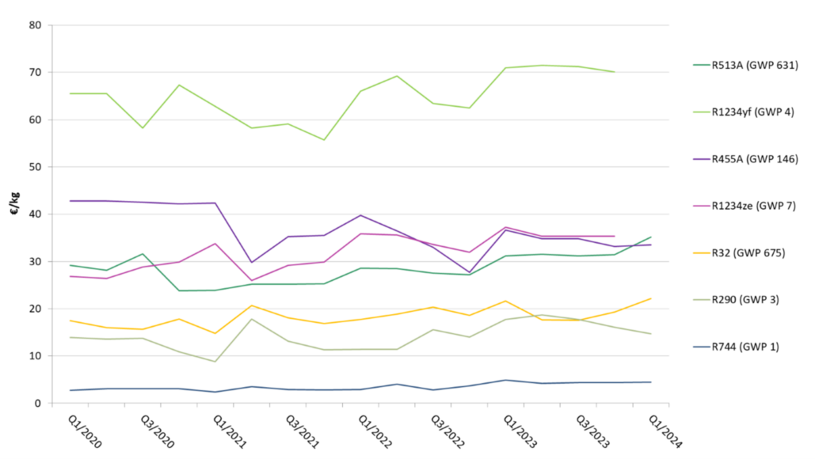Since March 11, 2024, the application of the EU F-gas regulation has set very ambitious targets in all sectors regarding the phase-out of HFCs (hydrofluorocarbons). As a result, prices of conventional refrigerants have increased steadily up to 1000% (see Figure 1) and higher from their initial prices of between 3 – 5 EUR/kg in 2014. In contrast, the prices of alternative refrigerants have remained stable since their levels in 2020, according to German environmental consulting firm Öko-Recherche.


When looking into different suppliers at the European level (eurorefrigerant.com, top-refrigerants.com, elgracool.pl, volmatsia.eu, alvadi.es), the prices for refrigerants with a high GWP are currently in the range of 30 – 45 EUR/kg, with the purchase price increasing steadily since 2014 (Figure 1). In contrast, the purchase prices of refrigerant alternatives are steady (Figure 2), with only propane (R290) and carbon dioxide (R744) being considerably cheaper (~5 – 15 EUR/kg) compared to the current prices of other high-GWP refrigerants. For more information also check out the European Environment Agency (EEA) Report (opens in a new window).
Another driver for higher prices of different refrigerants is the regulation of so called “forever chemicals” currently being discussed at EU level: per- and polyfluoroalkyl substances (PFAS [3]). Besides the natural refrigerants R290, R744 and refrigerant R32, all other refrigerants are known to decompose into PFAS (see Table 1). R1234yf, which is currently used in automobiles and is under discussion as an alternative to existing refrigerants, could therefore also face rapid price hikes.
Although the prices refer to the European market, the research demonstrates a clear trend which will also influence other regions. One driver is the countries’ commitment to the regional and national regulations for the phase out and phase down schedules of the Montreal Protocol and its Kigali Amendment.

The higher price of the greener solutions generally appears as a barrier that must be overcome. This is the case for the majority of cooling devices at the point of initial purchase, but due to greater efficiency of at least 10% when comparing R290 against R404A theoretically for most applications [4], green cooling solutions (opens in a new window) lead to lower energy consumption, and therefore lower electricity bills. The use of natural refrigerants such as hydrocarbons pushes the sector to decrease the leakage rate from cooling devices, reducing the need for refills. Finally, the prices of the refrigerants themselves are already shown to be having an impact on current and future policies.
Proklima has been supporting countries for over 25 years in implementing their commitment to Green Cooling Solutions and is a strong and reliable partner for the private sector for promoting them. As part of Proklima, the Greener Reefers (opens in a new window)project does this by promoting the use of natural refrigerants in maritime transport containers (known colloquially as “reefers”) as the only alternative that can be considered sustainable and environmentally friendly. Through networking and exchange, the Greener Reefer Transition Alliance promotes their statement: Greener Reefers are highly energy efficient, refrigerated maritime containers that use natural refrigerants and blowing agents with ultra-low climate impact (GWP below 11), and do not contain F-Gases and PFAS.
[1] Öko-Recherche, Monitoring of refrigerant prices against the background of Regulation (EU) No 517/2014, DG CLIMA support contract no. CLIMA.A2/SER/2020/0009MV (As of Q1 2024).
[2] Ibid.
[3] Per- and polyfluoroalkyl substances (PFAS) are a large class of synthetic chemicals that have been increasingly identified as environmental pollutants and linked to negative effects on human health. Trifluoroacetic acid (TFA) is an ultra-short chain type of PFAS, commonly found in the breakdown of F-gases.
[4] Minetto, S., et al. (2023). A review on present and f orthcoming opportunities with natural working
